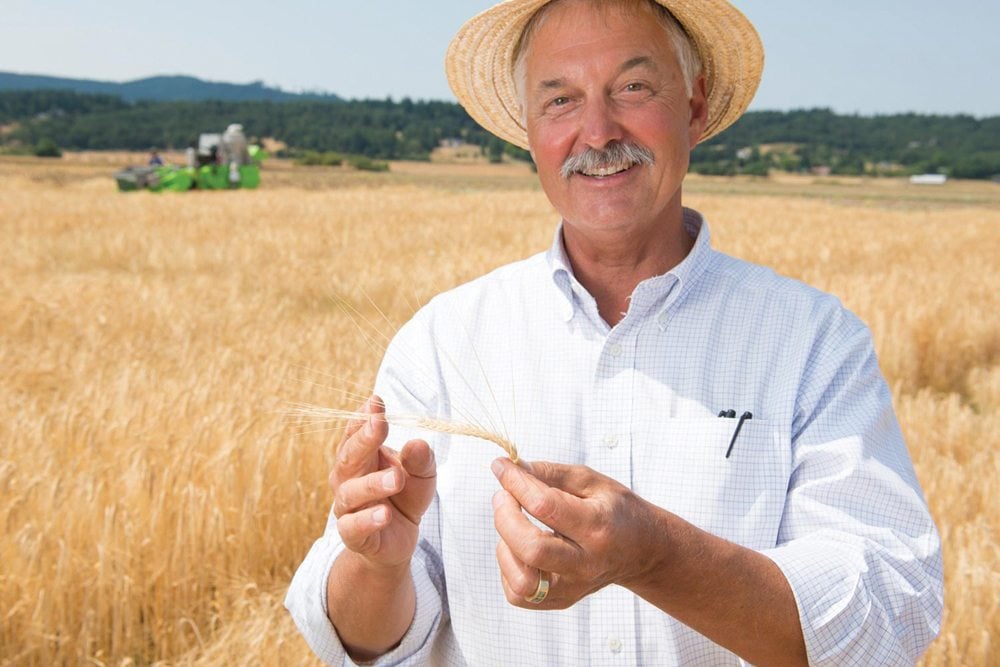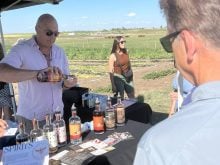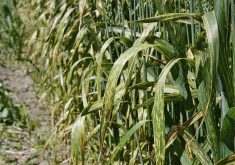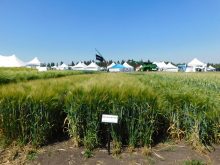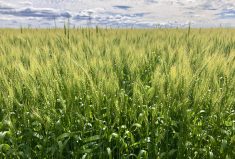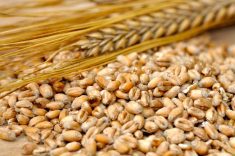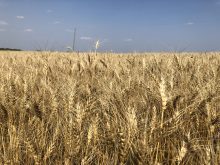Whisky from Scotland’s Isle of Islay. Champagne from its namesake region of France. Craft malt from Daysland, Alberta.
People will pay a premium for all sorts of specialty products — as long as they like the taste.
The brewing industry isn’t quite there yet, but it could be. Just ask Seth Klann.

“We’ll buy wine from France and whisky from Scotland,” said the owner of Mecca Grade Estate Malt in Madras, Oregon.
“I wanted to be set up to be like that with the malt barley flavour from our own farm.”
Five years ago, Klann began malting the barley grown on his 1,000-acre farm in central Oregon’s high desert, where days are hot and dry, nights are cool, and annual rainfall tops out at 10 inches. These unique growing conditions created a unique flavour in the malt — and Klann decided to capitalize on that.
“We really wanted to have products that don’t exist outside of our own operation and really can’t be reproduced outside of our own processes,” said Klann, who farms with his father and brother-in-law.
“We rolled the dice, and it worked out great for us.”
Today, his estate malt commands a big premium, fetching three times more than commercial malts.
“My challenge was in creating a luxury product out of something that’s been a commodity for so long.”
A key part of that was developing not only a proprietary malting process, but also a proprietary malt barley variety.
“We knew every single step of the process had to be unique in some aspect — all the way from the field to the finished pint,” said Klann. “Having our own varieties was really a big part of that.”

Working with Oregon State University, Klann began growing an heirloom two-row malt barley called Full Pint, an “oddball” variety that is hard to grow and malt, but packs a punch in the finished product. Klann’s goal was to help breed the flavour traits from older varieties into mainstream ones that are easier to grow and malt. And he’s about two years away from reaching that goal — a proprietary variety that has been bred exclusively for flavour in finished beer.
“There are thousands of different varieties of barley out there that no one has malted or made beer out of,” he said. “There’s a huge world of untapped flavour that no one’s doing anything with right now.”
Read Also

The long march to autonomy
The big players in the machinery market keep adding pieces towards autonomous vehicles for farming, but how far away is a final product?
Terroir trials
But variety is only one part of the equation.
Flavour is also affected by a region’s soils and growing conditions, something called ‘terroir.’ Most commonly linked to wine, it can impact other products, including coffee, spirits, and yes, even barley.
Oregon State University researchers trialled two varieties of malt barley — Golden Promise and Full Pint — on three different Oregon farms, including Klann’s. The barley was then micro-malted at Rahr Malting in Minnesota and made into beer.
Researchers found both varieties performed differently from each other (which was expected), but also performed differently at each location (which was not).
“There is a statistically significant effect on flavour from the environment,” said Oregon State barley breeder Pat Hayes.
Or, as Klann sums it up, “Each one of those beers was a completely different beer.”
The growing environment produces “subtly different” flavours, said Hayes, but in an industry that favours consistency over novelty, those differences don’t show up in the final product. There’s a reason that almost 81 per cent of the malt barley acres seeded in 2017 went to CDC Copeland and AC Metcalfe. They perform well agronomically, but more importantly, they produce a consistent product in the malt house.
“Brewers deal with those differences in the malt house and in the brew house so that they can arrive at a very consistent flavour profile,” said Hayes.
“To capitalize on those differences would flip the thing on its head.”
‘Pleasantly surprised’
That might work in central Oregon — but central Alberta? Who would pay a premium for CDC Copeland grown in Daysland?
It’s already happening, albeit on a small scale.
Like the Oregon researchers, Troubled Monk — a small craft brewer based in Red Deer — decided to see whether terroir impacted the flavour of its popular Golden Gaetz golden ale. Working with three different farms in three different parts of the province (near Daysland, Bashaw, and Drumheller), Troubled Monk brewed three batches of beer to see whether terroir changed the beer’s look, taste, and smell.
It did.
“Where this barley is grown does affect the flavour of the beer. And that’s pretty cool,” said Troubled Monk owner Charlie Bredo. “We know that terroir affects grapes, but we were pleasantly surprised that there was a noticeable difference in the beer.”
Right now, Troubled Monk sources local malt blended from different barley from different farms for its beers. But sub-regions of beer based on flavour could develop — just like wine and whisky sub-regions.
“It’s very preliminary, but over the next few years, this could potentially creep into commercial viability,” said Bredo.
Hayes agrees, saying, “Theoretically, it’s very doable for beer.”
In the increasingly diversified beer market, there might be room for both local brewers making a buck off regional differences and mainstream brewers sticking with a consistent product.
“Rather than wanting a consistent profile, we might want to capitalize on the differences,” said Bredo.
Alberta’s story
But while it may be theoretically possible, logistically it’s “a huge pain in the neck,” he added.
“Right now, it’s really hard to get the grain like this,” he said. “The cost of the malt becomes quite expensive — and then so does the cost of the beer. If we were going to mass produce it, we’d have to work on the pricing.”
Even so, the ‘buy local’ movement has proven that consumers are willing to pay more for locally produced products — as much as 30 per cent more, according to a 2016 study conducted by marketing firm LoyaltyOne.
The growing craft beer market is already tapping into that demand, and regional beers are a logical next step, said Matt Hamill, co-owner of Red Shed Malting.
“For these breweries to have a regional barley brewed into beer would capture that local movement. Any one of the breweries could latch on to that and have a good run with it,” said Hamill, who produced the malt for Troubled Monk’s taste test.
“We can do all of the ingredients right here in Alberta and make a phenomenal beer out of it. I think there’s an opportunity to do this on a large scale, but there’s a huge opportunity at any size to tell the Alberta barley story.”

Craft brewers around the world are already doing that, said Hamill, a 2017 Nuffield Canada scholar who explored the global barley value chain in the course of his studies. During his travels, he visited Little Creatures Brewing in Geelong, Australia, which created an ale (called Furphy) using only ingredients from the Victoria region and that can only be bought there as well.
“In that Melbourne area, you see the Furphy taps everywhere, and everyone is excited to tell you about it,” said Hamill. “They love saying, ‘This is from our farmers, this is from our area, and you can only get this here. So drink it while you can.’”
More locally, Siding 14 Brewing Company in Ponoka grows its own barley and hops, and works with Red Shed Malting to maintain that local connection.
“They’re really keeping that local story intact, and they have a beer they can be pretty proud about.”
From commodity to luxury
But for Klann, it’s not enough to be local, or to produce the same varieties the same way as everyone else.
“You really can’t charge a premium that way,” he said. “You have to make sure that every single piece of the process is special. Every single part of it has to have a story.”
And producers will need to change their mindset if they hope to differentiate themselves and tap into this highly competitive niche market, he added.
“If people are going to be serious about this, they have to be looking at it from a non-commodity mindset,” said Klann.
“You’re going to be going up against the big guys that can beat you up over price every day.”
At the moment, Klann is working with a select group of breweries in Oregon and California that want to produce beer with his unique malt but eventually, he plans to stop accepting new customers and level off his production.
“It’s more of an exclusive club that way, and that’s what makes it valuable.”
That’s the only way to make money at it at this point, said Klann — but for most producers, that would require a complete shift in thinking, away from commodity barley toward ‘luxury’ barley instead.
“We’re getting there — but we’re just starting to get there now. There probably will be a really good market for it someday,” said Klann.
“If you can do it right, I think there’s room for all sorts of regional flavours out there.”

